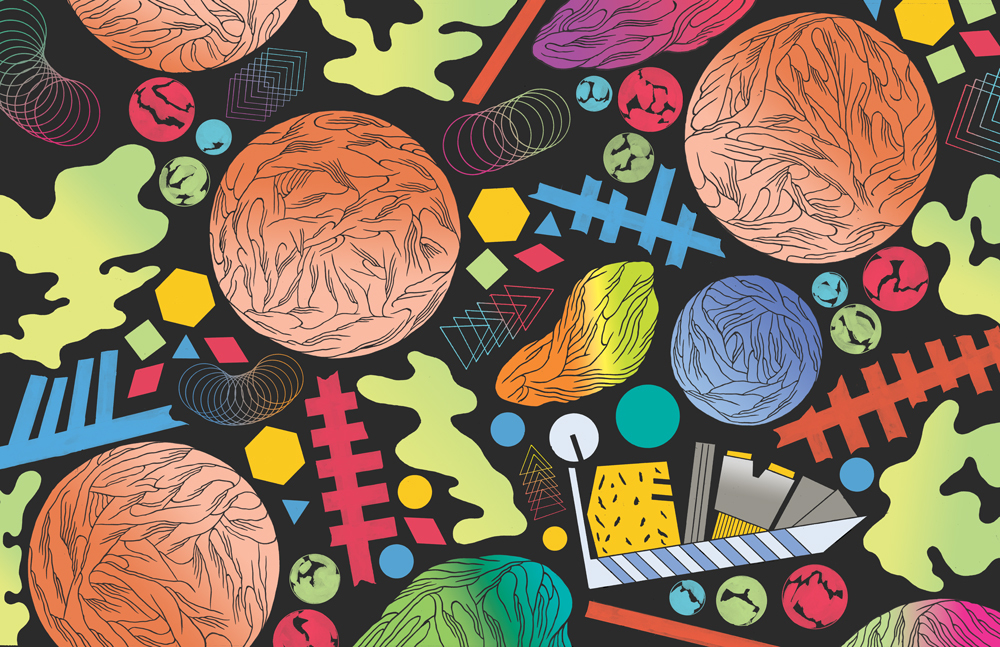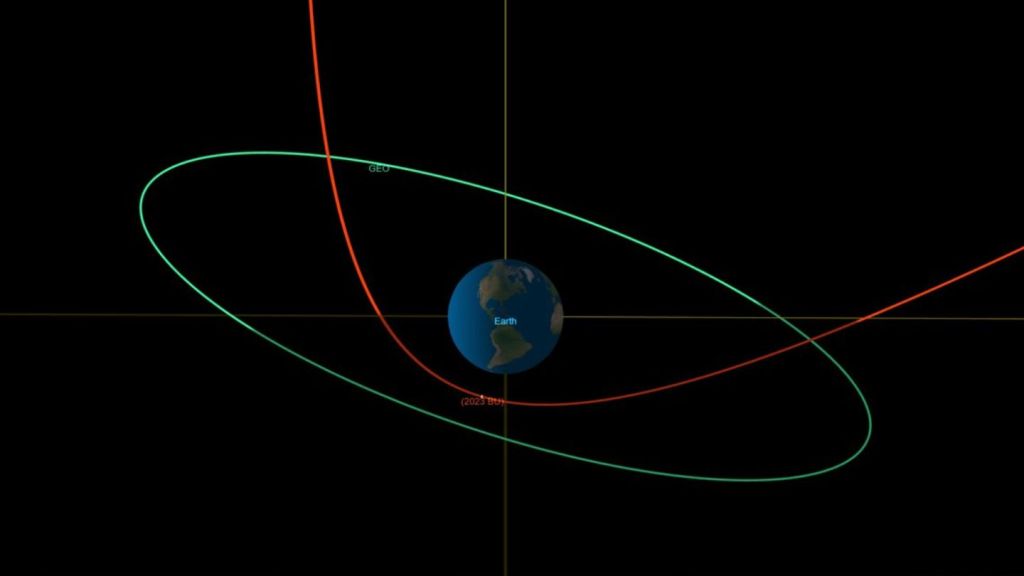
Illustration by Patrick Kyle
This article appears in the May Issue of VICE Magazine.
The sky god slept like a rock. In a yawning crater cut into the side of Manhattan’s Central Park, a stone as old as the Earth had amassed a crowd. I found it in a huddle of selfie sticks, flapping brochures, and children slapping it with sweaty palms. But Tomanowos, a divine messenger to Oregon’s Clackamas tribe, had suffered worse indignities over the years. Known to Westerners as the Willamette meteorite, the boulder crashed and burned many millennia ago. Glaciers raked the land with it an eon later. More recently, exhibitors amputated chunks of it that sold for astronomical sums at auction.
Videos by VICE
At the turn of the 20th century, treasure hunters took the idol from its worshipers and shipped it to the American Museum of Natural History. Here it sits in the Cullman Hall of the Universe, an enormous, white-tiled pit that funnels visitors straight into the meteorite’s orbit. Tomanowos is literally magnetic, given that it is 15 and a half tons of iron. The stone, which melted into the shape of an arrowhead during its descent, is the largest, most impressive meteorite ever discovered in North America. Eventually, even I yielded to its allure and reached across the railing.
As I dragged my hand across the rock’s cold, adamantine skin, it struck me as a harbinger of chaos, destruction, and entropy, the defining laws of nature. Native Americans hail the totem as a bringer of good luck. By an agreement with the museum, they hold private ceremonies in which they praise it in chants and bathe it in Labrador-tea and rose-hip elixirs. This attitude and its opposite, the irreverence of the children treating the stone like a jungle gym, suggested to me the spectrum of mankind’s relationship with asteroids. Seldom do we experience terror when glancing up at the sky. Parents would be loath to let their toddlers play tag around the burnished shell of a retired Fat Man or Little Boy, but here they were, making a hobbyhorse of a bomb. A more appropriate response would be dread.
Every year the Earth attracts 44,000 tons of galactic ash, enough muck over a century to sculpt a dozen Empire State Buildings. All this soot, the exhaust of the stars, is the afterburn of a never-ending blitz. Fist-size balls of molten iron strafe us every minute, warm-ups to more volatile blasts. In the last two decades NASA reported nearly 600 exploding meteorites, many as large as 60 feet, rattling the thermosphere like dynamite. Between 2000 and 2013, 26 struck the world with atomic force. The emperor of Japan once bowed to a 15-kiloton mushroom cloud, but some of these asteroids packed as much as a 600-kiloton punch. Two years ago one of them burst 20 miles above the city of Chelyabinsk, near the Ural Mountains, smashing countless buildings and injuring 1,491 Russians. The flare shone 30 times brighter than the sun, temporarily blinding 70 people and opening the eyes of everyone else: Earth-shattering impacts, it seemed, hadn’t ceased with the dinosaurs.
“There are at least a million near-Earth asteroids that could destroy a city or do worse,” said Ed Lu, a former astronaut and a leading authority on meteors. More frightening than their abundance is their anonymity, since we can stop them only if we can spot them. “NASA has found fewer than ten thousand of these—less than one percent,” he said of his former employer, which has devoted less than one percent of its budget to defending the planet against meteors. Man is as helpless as a brachiosaurus with its head in the sand.
Lu is one of the few scientists taking action against the threat of being collectively stoned to death. “NASA is reviewing a proposal to build NEOCam—the Near-Earth Object Camera—to look for asteroids, but it’s competing against twenty-something other missions for funding,” he said with a hint of doubt in his voice. Even if NEOCam gets off the ground, it will be a middling effort—catching only two thirds of asteroids larger than 460 feet, which could ruin vast swaths of the Earth, and overlooking many smaller hazards. Instead Lu has taken on the task of girding the entire world against the falling sky. He leads a team of astrophysicists at the B612 Foundation, an independent think tank named after the tamed space rock of The Little Prince. In the next few years they hope to launch Sentinel, a privately funded telescope that will map 90 percent of Earth-imperiling meteors. It will be the joystick in the human race’s high-stakes game of Asteroids.
“Asteroids are hot, so Sentinel will have an infrared lens,” said mission director Harold Reitsema, a veteran astronomer who discovered moons around Neptune and Saturn and designed some of the most important telescopes of our time. “But since infrared light’s long wavelengths can’t fully penetrate the atmosphere, we need to send it into space.” They’ll sail it deep into the void, anchoring it in the same orbital tide as Venus. Unlike other telescopes, Sentinel will point toward Earth rather than away from it, spying on objects darting across space. With its back to the sun, no glare will obscure its 170-million-mile watch. Sentinel will keep an unwavering gaze on the wandering rocks in our path.
Given its pedigree, B612’s pride and joy should make a cinch of its mission. Built by Ball Aerospace, which helped design the Hubble under Reitsema’s instruction, Sentinel will be an amalgam of older spaceborne aces. A Spitzer-inspired cooling system will keep the telescope at a constant negative 390 degrees, lest the ambient heat dazzle its infrared lens. Elon Musk’s 224-foot rocket, the SpaceX Falcon 9, will catapult it toward the sun. Once it arrives, a Kepler-style camera will track all the trajectories that should give us pause.
If Sentinel finds an impending impact, it will be one of the few types of natural disaster we are capable of diverting. In fact, swiping away a protoplanet speeding at 45,000 miles per hour is easier than most imagine. Atomic bombs would bust a large rock into pebbles. A kinetic impactor would change the course of a lesser one by giving it a nudge. Though it’s classic Newton, Reitsema helped prove the concept in the field during the Deep Impact mission, when a little shove from a minuscule probe rerouted a massive comet. For higher precision, we would send Lu’s gravity tractor to the rescue. In the slipstream of space, the gravity of a satellite near an asteroid would rechannel its orbit.
Like all tragedies, our death from above would be a problem of timing. Our current observatories would be too late in spotting a potential collision. When asked what we should do if we learn that an asteroid has us in its cross hairs, NASA director Charles Bolden gave a sobering answer: “Pray,” he said. Lu told me that if we found an asteroid headed in our direction, we would need at least ten years to divert it. Though Sentinel would buy us that time, not enough of us are buying the need for it, content to stick our thumbs in our ears and dismiss the people warning us as so many Chicken Littles.

Unsurprisingly, Lu and Reitsema say that Sentinel’s crucial challenge is funding. The nonprofit has raised only a fraction of the $450 million cost, which is chump change for a planetary life-insurance policy. Though B612 originally slated the launch for 2016, it’s had to delay liftoff to 2018 and, now, 2019. “The big question,” Lu said, “is whether protecting the Earth is worth the price of a freeway overpass.”
If humanity answered no it would not be surprising, given our refusal over the last few decades to spend even a pittance on shielding the sky. Neither NASA’s Planetary Defense program nor B612 nor any other serious venture has aroused a healthy fear of celestial bombardment. “It’s amazing that we humans have developed the ability to protect our planet from a process that’s been going on for billions of years,” Lu said. “But now the issue is whether we will have the foresight to follow through with it. This is the final exam for our civilization.” Of course, there are other final exams for our civilization—like reversing climate change—that we have failed with flying colors. Seemingly intent on destroying the planet, we rival asteroids in our talent for indiscriminate carnage. The human race is embracing its demise with alacrity.
After I visited Tomanowos, the largest meteorite ever found in North America, I didn’t think of it as benevolent sky god or as a quaint holding place for children’s chewing gum. When it crashed to Earth 10,000 years ago it likely brought about mass devastation, and it conjured in my imagination darker, more biblical connections—for instance the image of Sodom and Gomorrah, razed in a brimstone downpour. Like that airborne catastrophe, asteroids have been and will continue to be a scourge of mankind. This is the case today more than ever, in an age of unlimited ability and infinite arrogance. If we are now so stupid as to let one hit us, we will deserve it.
The impact may even have an upshot. Billions of years ago, asteroids seeded the Earth with the carbon compounds that would give rise to everything that swims, crawls, slithers, walks, or talks. They mete out life as well as death. If a meteor annihilates the human race, it may ensure the world remains a home.




